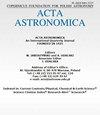OGLE-2017-BLG-0373Lb: A Jovian Mass-Ratio Planet Exposes A New Accidental Microlensing Degeneracy
IF 2
4区 物理与天体物理
Q2 ASTRONOMY & ASTROPHYSICS
引用次数: 7
Abstract
We report the discovery of microlensing planet OGLE-2017-BLG-0373Lb. We show that while the planet-host system has an unambiguous microlens topology, there are two geometries within this topology that fit the data equally well, which leads to a factor 2.5 difference in planet-host mass ratio, i.e., $q=1.5\times 10^{-3}$ versus $q=0.6\times 10^{-3}$. We show that this is an "accidental degeneracy" in the sense that it is due to a gap in the data. We dub it "the caustic-chirality degeneracy". We trace the mathematical origins of this degeneracy, which should enable similar degenerate solutions to be easily located in the future. A Bayesian estimate, based on a Galactic model, yields a host mass $M=0.25^{+0.30}_{-0.15} M_\odot$ at a distance $D_L=5.9^{+1.3}_{-1.95}$ kpc. The lens-source relative proper motion is relatively fast, $\mu=9$ mas/yr, which implies that the host mass and distance can be determined by high-resolution imaging after about 10 years. The same observations could in principle resolve the discrete degeneracy in $q$, but this will be more challenging.OGLE-2017-BLG-0373Lb:木星质量比行星暴露出一种新的偶然微透镜退化
我们报道微透镜行星OGLE-2017-BLG-0373Lb的发现。我们表明,虽然行星-宿主系统具有明确的微透镜拓扑结构,但该拓扑结构中有两种几何形状同样适合数据,这导致行星-宿主质量比相差2.5倍,即$q=1.5\times 10^{-3}$与$q=0.6\times 10^{-3}$。我们证明这是一种“偶然简并”,因为它是由数据中的间隙引起的。我们称之为“焦性-手性简并”。我们追溯了这种简并的数学起源,这应该使类似的简并解在未来很容易找到。基于银河系模型的贝叶斯估计得出了一个距离为$D_L=5.9^{+1.3}_{-1.95}$ kpc的宿主质量$M=0.25^{+0.30}_{-0.15} M_\odot$。透镜-源相对固有运动相对较快,为$\mu=9$ mas/yr,这意味着大约10年后可以通过高分辨率成像确定宿主的质量和距离。同样的观察原则上可以解决$q$中的离散简并,但这将更具挑战性。
本文章由计算机程序翻译,如有差异,请以英文原文为准。
求助全文
约1分钟内获得全文
求助全文
来源期刊

Acta Astronomica
地学天文-天文与天体物理
CiteScore
3.40
自引率
4.50%
发文量
0
审稿时长
>12 weeks
期刊介绍:
Information not localized
 求助内容:
求助内容: 应助结果提醒方式:
应助结果提醒方式:


